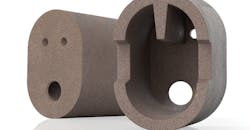Exothermic Inserts for Difficult-to-Feed Cross-Sections
In metalcasting, various feeding systems are available to eliminate shrinkage defects. Chemex’s patented, one-piece inserts for molds with vertical parting lines apply exothermic sleeves for areas where sand feeders customarily have been applied.
This new, engineered side-feeder makes it possible to feed cross-sections where hot spots have not been accessible with a sand riser installed on the pattern. The one-piece side-feeder is not molded onto the pattern plate; rather, it is inserted into the mold by the core-setter. It may be placed on any area of the casting and makes testing and modification achievable. Cycle times on automatic machines stay the same, with no slow down.
The feeder works for all castings where a side-feeder can be positioned on the mold partition. It also frees additional space on the pattern plate for more impressions on existing real estate, which improves both lead time and productivity.
Positioning of a side-feeder in the mold is important: the opening axis of the side-feeder insert must run below the volumetric center of gravity of the mold itself. The side-feeder retains the compressible features of the “tele-feeder” design, and features a tapered end on the casting surface, which enables simplified separation of the casting and feeder after casting.
A positioning pin used for automatic insertion of the feeder during core-setting also provides for core-gas ventilation during casting. The pin is always above the volumetric center and provides an easy path the gases emitted during mold filling.
These side-feeders are made of proprietary exothermic mixes bonded with high-strength cold-box resins. They can be stored for very long periods without change in strength properties, and exhibit the same high strength as the tele-feeder designs.
Given the exothermic properties, the efficiency of Chemex side-feeders is much higher than sand feeders. Because less feeding mass is required, it is now possible to produce more castings with the same production capacity, thereby improving yields.
Another advantage is that the feeder geometry provides directional solidification: the contact area between the feeder and the casting is optimized and reduced at the same time. This makes it easier to break off the riser, which reduces casting cleaning costs. In addition, two small openings provide excellent ventilation during pouring, reducing the potential of gas defects.
Svetlana Dodik-Pelja is the Business/Product Manager for Metal Feeding Systems, HA Intl. Learn more at www.ha-international.com
